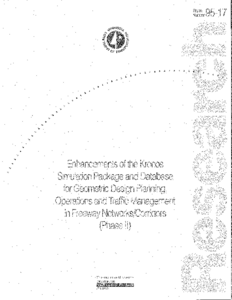Traffic Control for One-Lane Bridges
Date Created
1981-10
Report Number
82-01
Description
Enhancements of the KRONOS Simulation Package and Database for Geometric Design, Planning, Operations, and Traffic Management in Freeway Networks/Corridors (Phase III)
Date Created
1997-07
Report Number
1999-11
Description
Enhancements of the KRONOS Simulation Package and Database for Geometric Design Planning, Operations and Traffic Management in Freeway Networks/Corridors (Phase II)
Date Created
1994-12
Report Number
95-17
Description
An Interactive Simulation Program For Intersection Design And Operational Analysis
Creator
Date Created
1990-06
Report Number
91-07
Description
Summary of the Employment of the Traffic Management Laboratory (TRAMLAB) for Evaluating Ramp Control Strategies in the Twin Cities
Date Created
2002-06
Report Number
2003-06S
Description
Access to Destinations: Twin Cities Metro-wide Traffic Micro-simulation Feasibility Investigation
Creator
Date Created
2008
Report Number
2008-15
Description
Employment of the Traffic Management Lab for the Evaluation and Improvement of Stratified Metering Algorithm - Phase IV
Date Created
2007
Report Number
2007-51
Description
Employment of the Traffic Management Lab for the Evaluation and Improvement of Stratified Metering Algorithm - Phase III
Date Created
2007
Report Number
2007-13
Description










